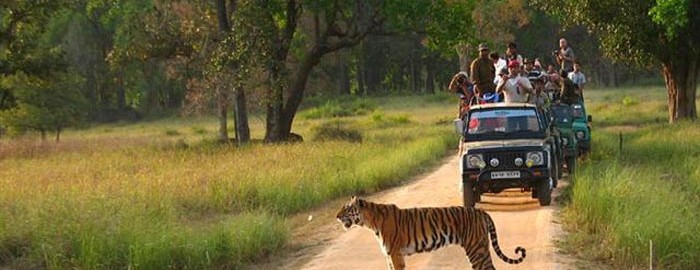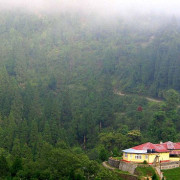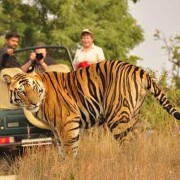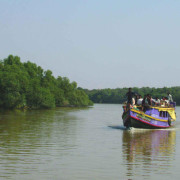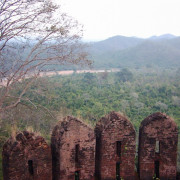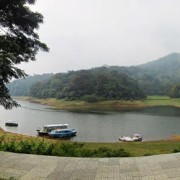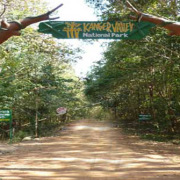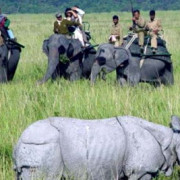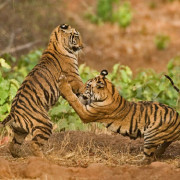Kanha National Park, Madhya Pradesh – A retreat of the Royal Bengal Tiger and various other wild species
Stretching over an area of 940 sq km Kanha National Park is one of the biggest park in Madhya Pradesh, India. The sal, and bamboo forests, the rolling grasslands and meandering streams cover the majority of the area of the National Park. This national park which is also a Tiger Reserve is located in the Mandla and Balaghat districts of Madhya Pradesh, India. In the 1930s, Kanha area was divided into two sanctuaries, Hallon and Banjar, of 250 and 300 km² . Kanha National Park was created on 1 June 1955. Since then, a series of stringent conservation programmes for the protection of the park’s flora and fauna has given Kanha its deserved reputation for being one of the finest and best administered National Parks in Asia, an irresistible attraction for all wildlife lovers and a true haven for its animal and avian population.Together with a surrounding buffer zone of 1,067 km² and the neighbouring 110 km² Phen Sanctuary it forms the Kanha Tiger Reserve. This makes it the largest National Park in Central India.
The park has a significant population of Royal Bengal Tiger, leopards, the sloth bear, Barasingha and Indian wild dog. The lush sal and bamboo forests, grassy meadows and ravines of Kanha provided inspiration to Rudyard Kipling for his famous novel “Jungle Book “.
Kanha national park has species of tiger, leopards, wild dogs, wild cats, foxes and jackals. Among the deer species Swamp Deer or Hard Ground Barasingha is pride of the place as it is the only sub species of swamp deer in India (Cervus duavcelli branderi). The animal is adapted to hard ground unlike swamp deer of the North which live in marshy swamps. Kanha National Park has been instrumental in rescuing the “Swamp Deer” from extinction. Indian Gaur (Bos guarus), belonging to the ox genus, is found in Kanha but seen mostly as winter ends. In summer gaur inhabit meadows and water holes in the park.
Other commonly seen animals in the park include the spotted deer, sambar, barking deer and the four-horned deer. The latter can be seen at Bamni Dadar climb. Recently, mouse deer have also been discovered in the tiger reserve.
Black buck were once found in Kanha, but became very rare for unknown reasons. They vanished completely, but have been reintroduced recently inside a fenced area in the park. Nilgai can still be seen near the Sarahi Gate, while the Indian Wolf once commonly seen at Mocha is a rare sight now. Hyena and sloth bear are seen occasionally. Langurs and wild boars are common, but the pugnacious rhesus macaque is seen less often.
Nocturnal animals like fox, hyena, jungle cat, civets, porcupine, ratel or honey badger and hares can be seen outside the park confines.
Reptiles like pythons, cobras, krait, rat snakes, vipers, keel backs and grass snakes are nocturnal animals, and are therefore rarely seen. There are many species of turtles as well as amphibians found in or near the water bodies.
Kanha and Satpura forest being a part of Gondwana, now famous as tiger reserve, once upon a time were ruled by wild Indian Elephants.
Places to see at Kanha National Park: Forest Department guides accompany visitors around the park on mapped-out circuits which enable viewers to see a good cross-section of Kanha’s wildlife. The best areas are the meadows around Kanha, where blackbuck, chital and barasingha can be seen throughout the day. In the 1930s, the Kanha area was divided into two sanctuaries, Hallon and Banjar, of 250 and 300 sq km each. Though one of these was subsequently disbanded, the area remained protected until 1947. Depletion of the tiger population in the years that followed led to the area being made an absolute sanctuary in 1952.
Nearby attractions around Kanha National Park: Near Kanha National Park is Bamni Dadar visited by every tourist who comes to the national park. It is the sunset point of this region from where the view of sunset is mesmerizing. The dense luxuriance of Kanha’s forests can be seen from here. Animals that can be sighted around this point are typical of the mixed forest zone: sambar, barking deer, gaur and four-horned antelope.
Kanha Museum
There is a museum at Kanha national park, showcasing the attributes and activities of the park and the tribal culture of the state of Madhya Pradesh.
The Baghira Log Huts
Located amidst the raw jungle, the restaurant of Baghira Log Hut, Kisli provides the visitors a chance to enjoy the nature at a close. In the wild, guests can take a ride to the jungle, venture further and explore the rich valley fed by rivers and lakes. In the dense sal and bamboo forests where over 350 species of birds and some rare flora and fauna flourish. One can indulge in generous dose of Birds watching, nature walks, swimming, fishing and boating and not the least tracking down the tiger in KANHA National Park.
Things to do at Kanha National Park: This destination is ideal for the nature and the wild life lovers. Here the wonders of nature will astonish you. Explore the entire site and savour the natural beauty.
Best Time to Visit Kanha National Park: The park is closed from July to mid-November during monsoon. The ideal season to visit the park is during winter which is quite pleasant here.
How to go ?
By Air
Nearest airport is at Jabalpur (156 km.), connected with regular flights from Delhi & Bhopal.
By Bus
Daily bus service available for Kisli and Mukki from Jabalpur and back. Taxis are available for hire from Jabalpur, Bilaspur and Raipur. Vehicles are not permitted within the park after dark.
By Train
Most convenient railheads are at Jabalpur and Bilaspur.
Where to stay ?
Kanha being a popular tourist destination has plenty of hotels suited to budgets. Some options are:
Kanha Village Eco Resort: +91- 9977853263 Website: www.kanhavillage.com
Mahua Tiger Resort: +91- 07566-656456 Website: www.thewildliferesorts.com
Note : Phone numbers given above are according to the information available with us. If you find any contact number/s given above is/are incorrect or not in use, please let us know.
.
.

